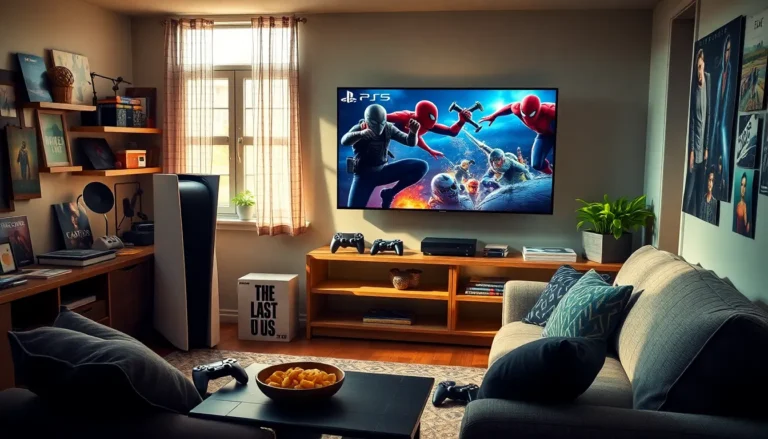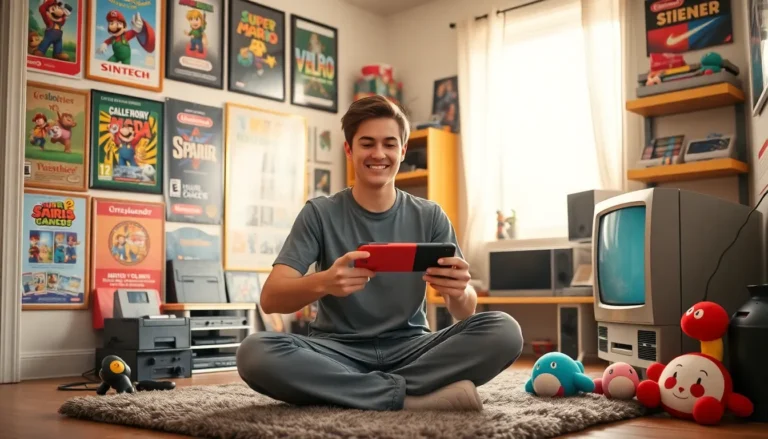From pixelated adventures to the thrill of portable gaming, the Game Boy has captured hearts across generations. It’s not just a console; it’s a time machine that whisks players back to simpler days when battery life was a precious commodity and “just one more level” was a universal motto.
Table of Contents
ToggleOverview of Game Boy Generations
The Game Boy system, launched by Nintendo in 1989, marked the beginning of portable gaming. Each subsequent release introduced innovative features, expanding the audience and redefining gaming experiences.
The original Game Boy featured an 8-bit processor and a simple monochrome display, appealing to gamers of all ages. Released in 1996, the Game Boy pocket shrank the design and enhanced battery life, making it more portable.
Following that, the Game Boy Color arrived in 1998, adding vibrant graphics and support for backward compatibility. Its introduction provided players with a broader selection of games, catering to diverse tastes.
Advancements continued with the Game Boy Advance in 2001, which offered a more powerful 32-bit architecture. Gamers enjoyed higher quality visuals and a wider screen, drawing in new fans.
In 2003, the Game Boy Advance SP introduced a flip design and built-in light, transforming how players engaged with the device. This model appealed to those seeking portability and convenience.
Nintendo further expanded the lineup with the Game Boy Micro in 2005, emphasizing a compact form factor. This handheld differentiating itself from previous models while maintaining compatibility with Game Boy Advance titles.
The legacy of the Game Boy generation continues to influence modern gaming consoles, with its impact evident in gaming culture. Nostalgia remains a driving force, connecting new players to the historical significance of the Game Boy.
First Generation: Game Boy
The original Game Boy launched in 1989, marking the start of a new era in portable gaming. With its distinctive gray shell and small size, it became a beloved device for gamers of all ages.
Key Features
The Game Boy featured an 8-bit processor, enabling it to run classic titles with ease. A monochrome LCD display improved visibility under various lighting conditions, although it lacked color. Battery longevity set a benchmark, allowing for approximately 10 to 30 hours of gameplay on four AA batteries. Its compact design facilitated portability, enabling players to take their gaming experiences anywhere. A simple interface and D-pad provided intuitive controls, making it accessible for both casual and dedicated gamers.
Iconic Games
Players fondly remember titles like “Tetris,” which epitomized addictive gameplay and became synonymous with the Game Boy. “Super Mario Land” introduced Mario to a new generation, showcasing platforming adventures on the go. “The Legend of Zelda: Link’s Awakening” captivated audiences with its engaging story and intricate puzzles. “Pokémon Red and Blue” revolutionized gaming, sparking a phenomenon that continues today. These iconic titles solidified the Game Boy’s place in gaming history, influencing future generations and remaining popular among gamers.
Second Generation: Game Boy Color
The Game Boy Color marked a significant advancement in handheld gaming. Released in 1998, it introduced color graphics, enhancing the visual experience for players.
Enhanced Graphics
Game Boy Color featured a 16-bit processor, allowing for over 32,000 colors on-screen. This leap in technology provided a vibrant and engaging display, elevating games to new levels. Developers embraced this, creating titles that maximized the console’s capabilities. Sprites, backgrounds, and character designs became more intricate, showcasing the potential of handheld gaming. Players enjoyed a richer visual experience, sparking excitement among both new and long-time fans.
Notable Titles
Numerous iconic titles emerged for Game Boy Color, cementing its legacy. “Pokémon Gold and Silver” became standout hits, allowing players to explore the Johto region. “The Legend of Zelda: Oracle of Seasons” and “Oracle of Ages” provided engaging puzzle-solving challenges. “Dragon Warrior Monsters” captured RPG fans with its engaging gameplay. Each title helped solidify Game Boy Color’s position in gaming history, continuing the trend of addictive and memorable experiences that started with the original Game Boy.
Third Generation: Game Boy Advance
The Game Boy Advance, launched in 2001, represented a major leap in handheld gaming. This generation introduced significant technical enhancements over its predecessors.
Technical Advancements
The Game Boy Advance featured a 32-bit ARM processor, which greatly improved performance. Its screen size increased to 2.9 inches, offering vibrant color graphics at a resolution of 240×160 pixels. Players enjoyed better audio quality due to upgraded sound capabilities. Additionally, the device supported backward compatibility with Game Boy and Game Boy Color games, enhancing its library. Battery life remained impressive, providing 15 hours of gameplay on two AA batteries.
Popular Franchises
Several franchises thrived on the Game Boy Advance, further establishing its legacy in gaming. Iconic titles included “Pokémon Ruby and Sapphire,” which introduced new generations of Pokémon. “Metroid Fusion” showcased exploration and combat in a 2D environment. The “The Legend of Zelda: The Minish Cap” engaged players with its charming graphics and innovative mechanics. Other favorites like “Mario Kart: Super Circuit” brought thrilling racing action to handheld devices. This array of franchises ensured diverse gameplay experiences for fans.
Legacy of Game Boy Generations
The Game Boy generations left a lasting legacy, shaping the direction of portable gaming. With each iteration, it introduced essential advancements that greatly impacted both game design and player engagement.
Impact on Gaming Industry
The Game Boy series revolutionized the handheld gaming landscape. Nintendo set a benchmark for mobile gaming with innovative hardware and engaging software. Developers expanded their creativity, crafting unforgettable titles that defined genres. Furthermore, backward compatibility ensured gamers could enjoy a vast library, solidifying the Game Boy as a cornerstone of gaming history. Its influence spurred competition, leading to enhanced features in subsequent devices, such as improved graphics and sound quality. Many consider the Game Boy a model for modern portable consoles, inspiring successors still present in the industry today.
Cultural Significance
Players fondly remember the Game Boy as more than just a gaming device. It became a cultural icon, symbolizing shared experiences and childhood memories. Game Boy aesthetics influenced pop culture, from fashion to art. Prominent franchises like Pokémon and Super Mario became household names, bringing people together and forming communities. The phrase “just one more level” resonates deeply with gamers, emphasizing the system’s addictive nature. The impact of Game Boy transcends generations, connecting both new and old players through nostalgia and shared joy.
Conclusion
The Game Boy generations have left an indelible mark on the gaming world. Each iteration brought advancements that not only enhanced gameplay but also fostered a sense of community among players. From the original Game Boy’s simple charm to the vibrant experiences offered by the Game Boy Color and the technical leaps of the Game Boy Advance, these devices shaped the future of portable gaming.
Their influence continues to resonate today, reminding players of cherished memories and shared adventures. The Game Boy isn’t just a console; it’s a cultural phenomenon that bridges generations, ensuring its legacy will endure for years to come.





